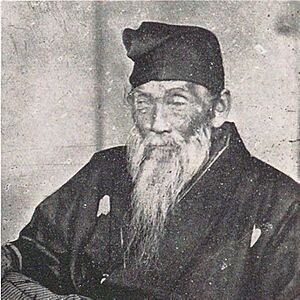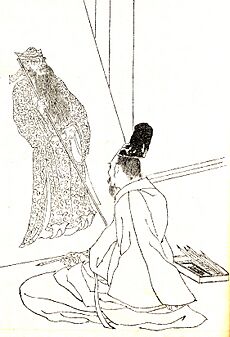Kikuchi Yōsai facts for kids
Quick facts for kids
Kikuchi Yōsai
|
|
|---|---|
 |
|
| Born |
Kawahara Takeyasu (河原 武保)
28 November 1788 |
| Died | Error: Death date (first date) must be later in time than the birth date (second date) |
Kikuchi Yōsai (菊池 容斎), born on November 28, 1788, and passing away on June 16, 1878, was a famous Japanese painter. He was also known by other names, like Kikuchi Takeyasu and Kawahara Ryōhei. Yōsai was best known for his amazing paintings of important people from Japanese history. He often used only one color (monochrome) in these portraits.
About Kikuchi Yōsai
Kikuchi Yōsai was born in Edo, which is now known as Tokyo. His birth father was a samurai, a type of Japanese warrior, named Kawahara. When Yōsai was young, he was adopted by the Kikuchi family.
When he was 18 years old, Yōsai began studying painting with a teacher named Takata Enjō. He learned many different styles of art, including the Kanō, Shijō, and Maruyama schools of painting. Even though he learned from these famous styles, Yōsai developed his own unique way of painting. His art sometimes looked a bit like the work of another artist named Tani Bunchō.
Yōsai was very dedicated to his art. He spent a lot of time researching history and even old objects to make sure his paintings of historical figures were as accurate as possible.
His Famous Work: Zenken Kojitsu
One of Kikuchi Yōsai's most famous works is an illustrated history book called Zenken Kojitsu. This book is a wonderful example of his skill in drawing with just black ink.
- Zenken Kojitsu features more than 500 important people from Japanese history.
- To create this book, Yōsai did a lot of research. He wanted to make sure his drawings were correct and showed how these historical figures really looked.
- The book was first printed in 1878 as a series of ten woodblock printed books. This means the pictures were carved into wooden blocks and then used to print the images.
Yōsai's Painting Style
Experts have studied Kikuchi Yōsai's painting style. A person named Nakane Kōtei noted that Yōsai's Zenken Kojitsu was inspired by a Chinese book called Wanxiaotang Zhuzhuang Huachuan. This book was drawn by an artist from the Qing dynasty in China.
Kōtei also believed that Yōsai was influenced by the famous Japanese artist Hokusai when he was younger. When Yōsai taught his own students, he paid a lot of attention to both the drawing and the calligraphy (the art of beautiful writing) in their work. He believed both were very important parts of a painting.


